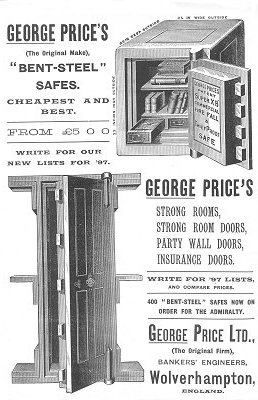|
page 4
The close of George Price's career
The death of the little boy in Burnley in 1860 must have caused great
remorse as well as public shaming to both George Price and William
Milner. In 1863, George published "a poem" called "The
Church of Christ". By and large, it's a four hundred and twenty
line Thesaurus of Religions, which includes the same kinds of questions
he asked about locks, keys and safes:
Of this Great Church, which is the purest branch?
Of forms of worship so very numerous,
There must be some that near perfection be,
Though in all earthly institutions, Imperfections will be found.…
There are Trinitarians and Arians,
Unitarians, Socinians, Arminians,
Antinomians, Calvinists, Brownists,
Presbyterians - English and Irish.
Wesleyan Methodists - Old and New;
Independents, Mystics, Quakers, Shakers,
Universalists, and Destructionists.
Sabbatarians and Moravians;
Swedenborgians and Moravians;
Baxterians and Hutchinsonians;
Lutherans and the Millenarians...
Oh, where is Christ's Church on earth to be found?
William Milner moved from Liverpool to the Isle of Man soon after the
Burnley incident. He was known as "the godfather of Port
Erin". He set up charities to help the poverty stricken fishermen
and in 1871 a tower was built out of local slate as a memorial "to
his many charities". Milner's Tower is a local landmark and stands
high on Bradda Head, impersonating a lighthouse. In fact it is built in
the shape of a key, with a spiral staircase inside. St. Catherine's
church in Port Erin was erected around 1879 with money from Milner's
will.
 |
George died, still very prosperous, in 1887.
He and William
Dawes produced first class safes, and his best ne plus ultra
locks remain unpickable to this day. Chubb has survived, Chatwood and
Milner survived as Chatwood-Milner, while Price was taken over by
Gibbons, in the 1930s economic depression, and the company name
disappeared. It seems that once George Price became old and frail,
no-one else had his fanatical drive and his sons were not interested.
George's third son, Bertie, in charge at the time of the takeover,
worked as office manager for Gibbons until some time during the Second
World War, when he was over eighty. He lived in mildly distressed
circumstances in a rented house, furnished with the relics of his
father's collection of clocks, musical boxes, tapestries, stuffed
squirrels and salmon in glass cases, beautiful dressers and a creaky old
safe full of Elkington plate silver. In the attic were three large oil
paintings: two of George and one of his father, Joseph, together with
George's copy of his Treatise. |
Since this article first appeared on this web site, Paul
Beasmore has kindly supplied an extract from the 1881 British Census,
showing 1 Millington Place, Upper Penn, where the following people were
listed:
George Price, Iron Safe and Lockmaster, employing 30 men
and 5 boys; aged 62; born Bilston.
Jane Price, wife; aged 60; born St. Georges, Shropshire
Lottie Price, daughter, aged 23, born Wolverhampton
Eva Price, daughter, aged 21, born Wolverhampton
Bessie Mills, visitor, aged 41, born Chelsea, Middlesex
Emma Jane Bowen, general domestic servant, aged 21, born Wednesfield
Sarah Hayward, nurse domestic, aged 49, born Ledstall Heath, Shropshire
This gives George's wife name as Jane, not Anne.
Upper Penn is a more up-market place to live than Wolverhampton
itself. It also had a more salubrious atmosphere - and it seems,
from the presence of a nurse domestic, that someone in the family was
suffering ill health.
Acknowledgements
Grateful thanks for invaluable help are due to Trevor Dowson, Peter
Scholefield, Tom Watson and Michael Chatwood.
Many of the illustrations come from the copies of George Price's
Treatises in the Wolverhampton City Archives.
Bibliography
Joseph Price A summary of Mr. Leigh 's History of the Cholera in
Bilston in 1832.Bilston, 1833. Available in Wolverhampton City
Archives
Joseph Price A Historical Account of Bilston from Alfred the Great to
1831. Published 1835. Available in Wolverhampton City Archives
George Price A treatise on fire and thief proof depositories and
locks and keys. Published by Simpkin, Marshall and Hall, London, 1856. Available
in Wolverhampton City Archives and the British Museum. Occasionally
available on internet antiquarian book sites.
George Price Forty Burglaries of the years 1863-4-5. Available in
Wolverhampton City Archives
George Price Gunpowder Proof Locks. 1860. Reprint available from Syd
Waterman, email: syd@lockcollectors.com
Barnsby, G. The working class movement in the Black Country
1750-1867. Wolverhampton, 1977
Burritt, E. Walks in the Black Country and its green surroundings.
Published circa
1870, reprinted by Roundwood, 1976. (Burritt was the American Consul)
Clare, A.C. The Chatwood Story. A.C.Clare, 1999
Hackwood, F. The Annals of Willenhall. Published by Walsall Local History
Centre, 1990
Haddon-Riddoch, S. Rural Reflections - a history of traps, trapmakers
and gamekeeping in Britain. Published by Argyll Publishing, 2001.
Available from the author at 1, Main Street East, Inverary, Argyll,
Scotland PA32 8TP
Hobbs, A.C. Construction of locks. Reprinted 1974 by Kingsmead
Prints, Bath
Raven, J. The book of the Black Country. Published by Broadside, Wolverhampton
,1989
Rees, E. Bilston in old photographs. Published by Wolverhampton Borough
Council 1988
Videos on antique locks and keys:
Watson, T. Antique Locks and Keys. Published by
Tom Watson, Master Locksmith. Email: detector1818@tiscali.co.uk
Newsletter for lock collectors:
Phillips, R. (ed.), Locks and Keys. Email: rphillips52@btinternet.com
Places to visit:
Willenhall Lock Museum
Bantock House Museum, Wolverhampton
Science Museum, London, has a complete set of George Price locks.
British Museum, London, has a copy of The Treatise.
Any comments on this article are welcome. Please email
pat@neiltempest.demon.co.uk
 |
 |
 |
| Return to
the last page |
Return to
the beginning |
Return to
the gazetteer |
|

